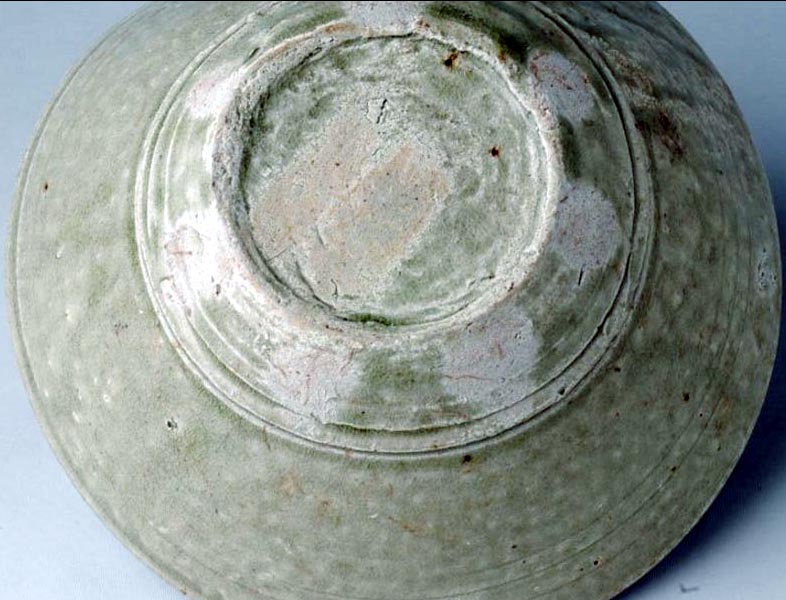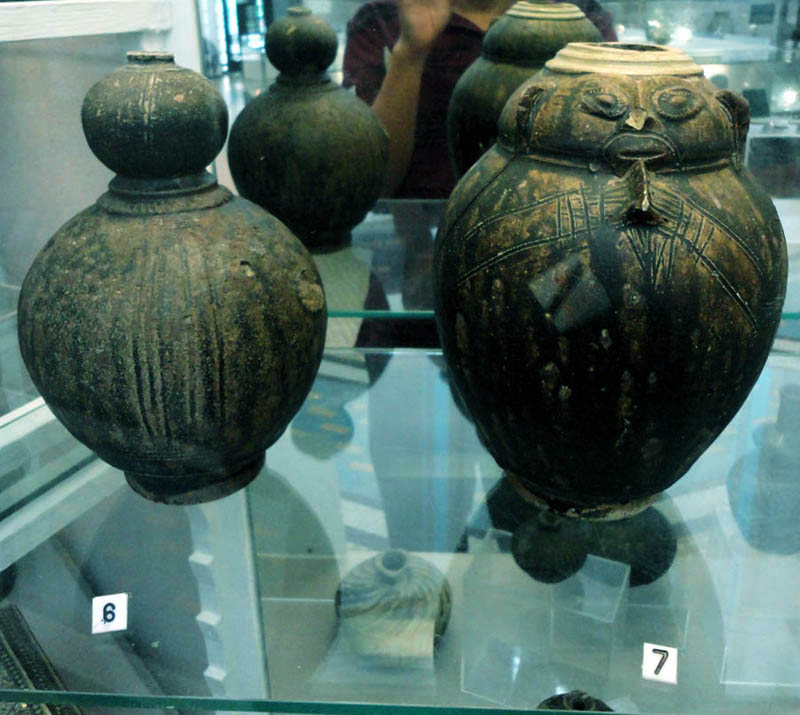Angkor Period (802 A.D - 1432) Khmer Ceramics
Archaeological excavations showed that the Southeast Asian region started producing pottery during the pre-historic phase. However, the manufacture of glazed ceramics, an invention of the Chinese civilisation, was most likely first introduced in Northern Vietnam which was conquered by the Han Dynasty. There are some Han style ceramics found in Northern Vietnam. There are some stylistic differences and the paste appeared to be different from those made in China. However, no kiln sites of the period has been discovered yet. Nevertheless, by the 9th to 10th century, both Vietnam and Cambodia were already producing sizeable quantity glazed ceramics. Their appearance at this point of time is not coincidental. The first wave of export Chinese ceramics commenced during the late Tang period (9th century A.D). Major kilns which fed the export market included wares from Zhejiang Yue, Hunan Changsha, Hebei Xing/Ding and Guangdong. Majority of the vessels were glazed with a celadon green glaze. Although Xing white wares were already famous during the period, they constituted a relatively small portion of the export ceramics.
The first recorded find of Khmer glazed ceramics was made by Etienne Aymonier in 1883. In a village at Anlong Thom located in Phnom Kulen, he discovered light greenish/yellowish green tiles, bowls, jars, box covers and etc. The local villagers called the village Sampou Thleai, literally meaning smashed junk. According to legends, a Chinese junk was wrecked and washed ashore Phnom Kulen. The fortunate Chinese survivors settled down there and started producing glazed ceramics for livelihood. As in most legends, the facts and fictions are so entangled that it is difficult to determine the truth. Phnom Kulen is inland and the nearest vast expanse of water is Tonle Sap lake which is located too far away for a wrecked junk to end up in Phnom Kulen. Despite the lack of plausibility of the legend, the Chinese connection of the Phnom Kulen kilns appears strong. Those light greenish vessels resembles the glazed ceramics produced in Guangdong during the 9th/10th century. Based on Chinese records, the Chinese had contact and information on the region which was called Chenla. Chenla was reputed to be rich and diplomatic and trade links existed with China. An interesting evidence of Chinese presence could be found in the Bayon gallery of relief carvings dated to the late 12th/early 13th century. Although this does not directly proves Chinese presence in the 9th/10th century, it does suggested the possibility of earlier settlement of some Chinese among the Khmer community. In one of the relief carvingss, it shows two Chinese engaging in the game of cock fighting with the locals.
Two bearded Chinese on the right
Light Green Glaze ceramics wares
Among the wasters at Phnom Kulen are some light green ceramics roof tiles. The similarity of the motifs and glaze colour/texture of those tiles with those found in the Guangdong Nanhan palace site is striking. The Nanhan light green glazed roof tiles were products of Guangdong kilns.The state of Nanhan existed from A.D 917 to 971, after which it was conquered by the Northern Song army.
|
|
|
|
|
|
Roof tiles found at Phnom Kulen |
 |
|
Roof drainage and column parts found at the Nanhan palace site in Guangzhou
Since the discovery of the light green ceramics wares at Phnom Kulen, the term ôKulen" was used to refer to those vessels with light transparent greenish/yellowish green glaze which typically has fine crackles. In terms of the glaze colour and texture, they are similar to those produced in Guangdong period during the 9th/11th century. The below jars, top Guangdong and bottom Khmer, show the similarity of the glaze.
|
|
|
|
 |
 |
 |
Light green bowls dated to 10th century. The bowls were fired in stacks with bowls separated by clay balls on the lower outer wall. The round marks left by the balls could been seen on above bowl. |
|
Nanhan Guangdong Green glaze cover box |
|
|
10th Century Khmer green glaze cover box. Such boxes were made by Khmer potters during the initial phase of production. The quality is more crude and rough as compared to the Guangdong version. They were produced during the 10th century. |
|
|
Northern Song (11th cent.) Qingbai cover boxes from Guangdong Chaozhou Bijiashan kiln
|
|
|
Box cover with knob includes those shaped in the form of fruit bud. The height of the boxes also became taller. They made their appearance during the 11th century, paralleling the evolvement of the shape of cover boxes from Chinese kilns.
|
|
|
The vase on the righ with multi-tier mouth most likely made its appearance during the later part of 10th/early 11th century. The two on the left without the multi-tier mouth are most likely dated earlier. |
By the 12th century, unique khmer pots in animal form were produced. The zoomorphic forms included elephant, owl, human face, cat, rabbit, wild boar and etc. Both light green and dark brown glaze types were produced.
Brown Glaze ceramics wares
Based on the archaeological findings from ancient temple and kiln sites, dark brown glaze vessels made their appearance by the turn of the 11th century. So far, most the kilns that produced the dark brown glaze wares were located in Northeastern Thailand region of Buriram and Surin. In Phnom Kulen kiln sites at Thnal Mrech, some brown glaze wares were discovered.
|
|
|
|
Late 11th/12th Cent. Cover box |
By the 12th century, a unique baluster-shaped vase with ribbed foot was produced and represented one of the most unique khmer vessel form. The multi-tier mouth and tall tapering ribbed foot are unique features found on khmer ceramics jars.
|
|
|
|
|
|
|
Two 12th century baluster shaped vase with the ribbed foot
|
|
|
|
|
|
A 12th century cover jar with ribbed foot
|
|
|
|
|
|
A 12th century jar with ribbed foot |
|
As mentioned earlier in the section on light green glaze wares, zoomorphic form pots represented another form of unique Khmer ceramics.
 |
| 12th
century human face jar and a gourd-shaped dark brown glaze vase in the
Ho chiminh museum
|
|
|
|
A
12th century elephant form brown glaze pot
|
|
|
| Two
12th century small pots. The one on the right is shaped in the
form of an owl
|
|
|
|
|
| A 13th century lime-pot in the shape of elephant. Those zoomorphic form vessels dated to 13th century are more heavily and roughly potted. |
Another two common forms which emerged during the 12th century were vases with narrow long neck and squat jars which is commonly termed as honey pots. For both, most likely they took their form from Chinese examples.
|
|
|
| 12th cent. vase with long neck | 12th cent. Fujian Dehua long neck white glaze vase |
|
|
|
| 12th cent. squat jar commonly referred to as honey pot | 12th cent. Fujian kiln white glaze squat jar |
Another interesting form of khmer ceramics are bowls with a disc shaped protrusion at the inner centre. There is still no consensus on its actual usage. Some suggestions include its use as an oil lamp or cover for jar. They are usually dated to late 11th/12th century.
|
|
|
| 12th century brown bowl with disc shape protrusion on inner base | |
Another common object both found in light green and brown glaze is ceramic conch. They are particularly popular during the 12th/13th century period. It is an auspicious object in the Hindu and Buddhist religion and may have served as an object for ritual purposes.
|
|
|
| Brown glaze conch most likely dated to 13th cent. in view of its more crude and heavy potting. Those from the 12th century are more elaborate and more fine in term of workmanship. | |
Combination of light green and Brown Glaze ceramics wares
Besides light green and brown glaze wares, by the 11th century the Khmer potters also started production of wares using both light green and brown glaze.
|
|
 |
| 12th cent. gourd-shaped vase using both light green/brown glaze | 12th cent. Chinese qingbai gourd-shaped vase |
Concluding remarks
According to Wang Dayan, a member of the Chinese diplomatic mission to Angkor in A.D 1297, the locals liked to use porcelains from Quanzhou and Chuzhou (ie longquan). The preference for Chinese ceramics is substantiated by the relatively larger number of Chinese ceramics finds from the 14th century as compared with earlier period. Hence, the change in consumer taste very likely resulted in the decline in the production and quality of Khmer ceramics. Coupled with the declining power of the Angkor empire, by the 15th century production of Khmer ceramics most probably ceased or only continued to be produced in very small scale. But it should be noted that the Khmer ceramics tradition did not disappeared. Jars bearing strong Khmer stylistic imprints in terms of the shape and impressed motifs, were produced in the 14th century in the kilns of Suphan Buri and Si Satchanalai in Northern central Thailand. This most probably involved the migration of potters from Northeastern Thailand and likely linked to the rise of the Thai Sukhothai kingdom.
14th Cent. Northern Central Thai Jar
Written by : NK Koh (23 Jun 2013)
References:
The Ceramics of Southeast Asia - Their Dating and Identification - Roxanna Maude Brown